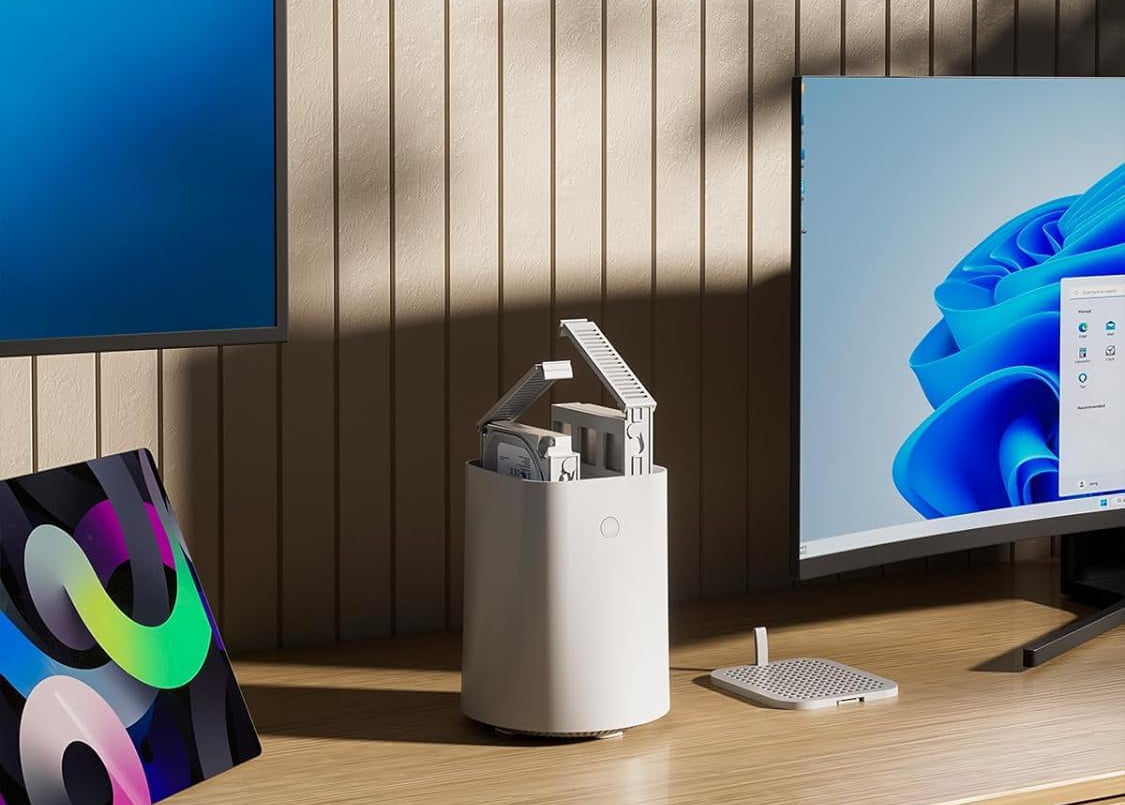For this second edition of the Monthly Tech Bulletin, we look at all the latest mobile SoCs and portable SSDs that made their world debut. We also look at a brand-new DJI camera and Xreal AR glasses.
- GOOGLE ANNOUNCED THE CHROMEBOOK PLUS PROGRAM
- SHARP AQUOS SENSE8 BRINGS SNAPDRAGON 6 GEN 1 AND DISPLAYPORT ALT
- MURENA 2 BRINGS A DEGOOGLED EXPERIENCE OUT OF THE BOX WITH A KILL SWITCH
- SAMSUNG'S T9 PORTABLE SSD FEATURES USB 3.2 GEN 2×2
- GOOGLE UNVEILS THE PIXEL 8 SERIES WITH SEVEN YEARS OF SOFTWARE SUPPORT
- SAMSUNG SHOWCASED THE EXYNOS 2400 WITH AMD RDNA 3 ARCHITECTURE
- QUALCOMM TO BRING RISC-V FOR FUTURE WEAR OS SMARTWATCHES
- OPPO FIND N3 AND ONEPLUS OPEN LAUNCHED GLOBALLY WITH HASSELBLAD TRIPLE CAMERA
- XREAL AIR 2 SERIES BRINGS A NEW DISPLAY TECHNOLOGY AND ELECTROCHROMIC DIMMING
- QUALCOMM ANNOUNCED THE SNAPDRAGON 8 GEN 3 AND SNAPDRAGON X ELITE
- DJI OSMO POCKET 3 PACKS A 1” SENSOR AND ROTATING SCREEN
- AOOSTAR R1 DEBUT AS A "MINI PC x NAS" COMBO
- XIAOMI 14 SERIES LAUNCHED WITH SNAPDRAGON 8 GEN 3 AND A REVAMPED OS
- KHADAS MIND AVAILABLE TO PURCHASE THANKS TO HUGE CROWDFUNDING SUCCESS
- LEICA M11-P LETS YOU CHECK YOUR PHOTOS FOR ORIGINALITY AND AUTHENTICITY
- ADATA SE920 ANNOUNCED AS THE FIRST USB4 PORTABLE SSD
GOOGLE ANNOUNCED THE CHROMEBOOK PLUS PROGRAM

While ChromeOS still has its place among avid Linux enthusiasts, not forgetting the addition of Play Store mobile app support, it never managed to be a viable competitor to Windows due to the absurd price-per-specification difference. Such a disadvantage is what drives Google to launch the Chromebook Plus program. The aim? To bring higher-end specifications at a more affordable price.
Like Intel’s EVO program, Chromebook Plus must adhere to rules set by Google to qualify for such certification. It includes CPUs from at least Intel Core i3 12th Gen or AMD Ryzen 3 7000 series, 8GB+ RAM, 128GB+ storage, 1080p resolution with IPS or better screen panel, and 1080p+ webcam with Temporal Noise Reduction. Chromebook Plus laptops will be available from October 8th, with $399 as the starting price.
SHARP AQUOS SENSE8 BRINGS SNAPDRAGON 6 GEN 1 AND DISPLAYPORT ALT

Sharp might not sell its smartphones globally, but that doesn’t mean it lose popularity in its home country, Japan. The latest Aquos sense8 shows that Sharp is still doing fine in the smartphone market. It’s a successor to the sense7, although you can’t tell much from the design as they both look identical.
However, the new phone has Qualcomm’s latest midrange SoC, the Snapdragon 6 Gen 1. It also brings a much bigger 5000mAh battery (compared to the sense7’s 4,570mAh battery), a 90Hz screen refresh rate, and OIS for the existing 50.3MP 1/1.55” primary wide camera. While the 3.5mm audio jack and microSD card slot remain intact, you can now use the phone for wired casting/screen mirroring as it supports DisplayPort video output. Priced at JPY 62,150, it’ll only be available through NTT Docomo, au, Rakuten Mobile, and UQ Mobile carriers.
MURENA 2 BRINGS A DEGOOGLED EXPERIENCE OUT OF THE BOX WITH A KILL SWITCH

While there’s no denying the massive use of Google Mobile Services on smartphones, there are people who feel uncomfortable sharing their data and privacy with corporations, particularly for advertisement tracking. Such concern leads e.foundation, a French company that developed the privacy-focused /e/OS, to build smartphones under their Murena branding.
The Murena 2 is the company’s second release and aims to bring better personal privacy with an all-new privacy and disconnection switch. The former allows you to instantly switch off the smartphone’s camera and microphones, which also creates a circuit block that prevents hackers from accessing either hardware, and the latter activates Airplane mode and mutes the phone.
While the screen is slightly smaller than before at 6.43”, it’s now a 20:9 Super AMOLED panel. 128GB internal storage remains, but the RAM has been increased to 8 GB. The rear camera also received new hardware with a 64MP primary wide camera and 13MP secondary camera, although the company has not disclosed which type of secondary camera. The SoC is also not mentioned in the specification, although it quoted 4x 2.1GHz and 4x 2.0GHz. At this time of writing, the Murena 2 is only available through pre-order at Indiegogo for €499, with shipping expected to happen by December 2023 at the earliest.
SAMSUNG’S T9 PORTABLE SSD FEATURES USB 3.2 GEN 2×2

If you’re looking for a new portable SSD hard drive, you may want to check out Samsung’s latest offering. The T9 is the brand’s first model to adapt a USB 3.2 Gen 2×2 interface, which gives a hugely impressive transfer speed of 2,000MB/s. That is twice that of its predecessor, the T7, which uses a Gen 2×1 interface. To keep the pace at such speed, it features a Dynamic Thermal Guard that minimizes performance drop caused by overheating. Three storage tiers will be available with prices starting from $139.99 for 1TB and going all the way to $439.99 for 4TB. It’ll come with USB Type C-to-C and USB Type C-to-A cables in the box.
GOOGLE UNVEILS THE PIXEL 8 SERIES WITH SEVEN YEARS OF SOFTWARE SUPPORT

After many leaks, Google finally unveiled the Pixel 8 series. While they don’t look much different from its predecessor, the Pro version now sports a flat screen panel and a redesigned rear camera island. Both phones are getting a new upgrade for the ultrawide camera, with the Pro version getting an all-new 48MP sensor and the vanilla version getting autofocus support from the existing sensor. The show’s main star is the all-new Tensor G3 SoC with a Nona-core CPU and Mali Immortalis-G715s GPU. Shipped with Android 14 out of the box, Google has put a lot of AI dough into the new SoC as it features Magic Editor and Audio Magic Eraser, to name just two.
Google also focused on long-term longevity as the new phones will get promised seven-year software support alongside extended hardware support with spare parts available throughout the software support period. Both phones have 128GB as the base storage tier, with prices starting at $699 for the vanilla version and $999 for the Pro version.
SAMSUNG SHOWCASED THE EXYNOS 2400 WITH AMD RDNA 3 ARCHITECTURE

Exynos might still not be as popular as Snapdragon or Bionic, but it hasn’t stopped Samsung from showcasing the Exynos 2400 during the System LSI Tech Day in California.
Being a direct successor to the current Exynos 2200, Samsung claimed an increased CPU performance by 1.7x and a 14.7x boost in AI performance. Samsung also revealed the Zoom Anyplace technology based on the 200MP camera sensor, which brings an entirely new camera zoom experience and AI-based tracking technology. The GPU also saw an upgrade as the AMD-collaborated Xclipse 940 GPU was built upon AMD RDNA 3 architecture and showed enhanced ray tracing capabilities. No word on the first smartphone to utilize this SoC, although rumours point toward next year’s Galaxy S24 and S24+.
QUALCOMM TO BRING RISC-V FOR FUTURE WEAR OS SMARTWATCHES

Until now, ARM has always been the most preferred architecture for mobile devices, including smartwatches. However, being a proprietary architecture means you must depend on its owner for future development and pay royalties to use it.
Enter RISC-V, an open-source, royalty-free architecture that could power the next generation of mobile computing. It certainly doesn’t skip the attention of Qualcomm and Google as they reached an agreement to bring RISC-V to future Wear OS smartwatches. Going for RISC-V allows any OEM to develop their own completely custom cores, which can create increased innovation and competition. Since this is still a work in progress, don’t expect to see RISC-V Wear OS smartwatches until the foreseeable future.
OPPO FIND N3 AND ONEPLUS OPEN LAUNCHED GLOBALLY WITH HASSELBLAD TRIPLE CAMERA

Oppo and OnePlus launched their latest horizontal foldable smartphones in two separate event launches. The Find N3 is Oppo’s third generation model of the line, while the Open is the OnePlus’s first introduction to the foldable world. Both phones are identical, with the only difference being the colour choice, ColorOS or OxygenOS, and region availability.
They feature an LTPO3 screen panel on the outer 6.31” 20:9 screen and the inner 7.82” screen alongside IPX4 splash resistance. They are powered by Qualcomm’s Snapdragon 8 Gen 2 SoC with 512GB as the base internal storage capacity and 12GB or 16GB RAM, depending on either model. The triple camera hardware, which consists of a 48MP 1/1.43” wide camera, a 64MP 1/2” 3x zoom telephoto camera, and a 48MP 1/2” 14mm ultrawide camera, has been given Hasselblad Colour Calibration treatment. The battery is a 4,805mAh unit with a 67W wired charging rate and reverse wired charging capability.
The OnePlus Open is available in the USA and Canada in 16/512 configuration for $1,699. In Malaysia, the Oppo Find N3 in the same configuration cost MYR 7,999.
XREAL AIR 2 SERIES BRINGS A NEW DISPLAY TECHNOLOGY AND ELECTROCHROMIC DIMMING

Rejoice, AR glasses fans! XREAL has launched the second generation of Air, aptly named Air 2. While it looks identical to its predecessor, it has been redesigned with a new zero-pressure nose pad, ultra-soft temples, and an improved 1:1 weight ratio. The display has a smaller Sony-sourced 0.55” micro-OLED panel with 500 nits of brightness and a native 120Hz screen refresh rate. The Sound System audio has been updated for a richer and more immersive sound and features Directional Audio technology that reduces sound leakage.
XREAL also launched Air 2 Pro with a brand-new electrochromic dimming feature that allows three levels of screen immersion. Both versions will be available on XREAL’s official website, with the Air 2 retails at $399 and the Air 2 Pro only costing an extra $50.
QUALCOMM ANNOUNCED THE SNAPDRAGON 8 GEN 3 AND SNAPDRAGON X ELITE

It’s a busy day for Qualcomm as they reveal their latest SoC offering during the Snapdragon Summit 2023 event in Hawaii. Built on a 4nm process, AI is the central key of the Snapdragon 8 Gen 3. Qualcomm has developed the AI Engine to support on-device multi-modal generative AI models, mostly involving language and speech recognition. The camera has also been given AI treatment as it features Arcsoft’s Video Object Eraser. Outside AI, the 8 Gen 3 returns to a triple-core cluster setup with a single Cortex-X4 Prime core, five Performance cores, and two Efficiency cores. It’s also the first mobile SoC to support 8K@30Hz and FHD@240Hz external display.
Another SoC making the splash is the X Elite, which replaces the 8cx Gen 3. Like the 8 Gen 3 mobile SoC, it was built on a 4nm process. However, the main talking point here is the all-new Oryon CPU architecture with 12 3.8GHz high-performance cores and single/dual core boost up to 4.3GHz. 8-channel LPDDR5x-8533 memory allows up to 64GB RAM capacity. It also supports up to three 4K/60Hz HDR10 external displays through DisplayPort v1.4 and two 5K/60Hz external displays.
Expect the 8 Gen 3 to debut on consumer smartphones as early as November 2023. Unfortunately, the X Elite won’t see any action on consumer Windows PCs until mid-2024.
DJI OSMO POCKET 3 PACKS A 1” SENSOR AND ROTATING SCREEN

It has been three years since the Pocket 2 was launched, so it’s about time DJI launched an upgraded successor while also bringing back the Osmo branding that was dropped from the previous model. The Osmo Pocket 3 sees a massive change in the camera department as it now sports a 1” CMOS sensor with full-pixel autofocus and three-axis mechanical gimbal stabilization. The new camera sensor allows 4K/120fps video recording and 10-bit D-Log M or HLG colour modes for professional-level creations.
Another change for the new model is the new rotatable 2” OLED touchscreen. The 1300mAh battery can be charged up to 80% in 16 minutes using DJI’s 65W PD charger and can record up to 116 minutes of 4K/60fps footage when fully charged. The new model will be retailed at $519. There’s also the $669 Creator Combo package, which includes a microphone transmitter, a microphone windscreen, a clip magnet, a battery handle, a tripod, and a carrying bag.
AOOSTAR R1 DEBUT AS A “MINI PC x NAS” COMBO

You won’t be short of choice for standalone mini PCs and standalone Network Attached Storage (NAS) machines in the market, but what about combining those two into a single body? Sounds impossible? Not to a relatively new upstart from China called Aoostar. The R1 and the R7 might look like typical mini PCs, but they can pull double-duty as NAS machines.
Both models feature a rich collection of I/O ports with two 2.5Gbps LAN, four USB-A, DisplayPort 1.4, HDMI 1.4, USB-C with 100W Power Delivery support, a 3.5mm audio jack, and a microSD card slot. The piece de resistance, however, is two 2.5″/3.5″ SATA slots capable of handling up to 40TB of NAS data. Both models can be specified as a barebone unit a la Intel NUC or pre-installed with 16/32GB RAM and 512GB/1TB SSD storage.
The only difference between the two is the CPU with Intel N100 CPU powering the R1 and AMD Ryzen 7 5700U powering the R7. They can be purchased from Amazon or Aoostar’s official website with prices ranging between $199 for barebone R1 to $439 for R7 with pre-installed 32GB RAM and 1TB SSD storage.
XIAOMI 14 SERIES LAUNCHED WITH SNAPDRAGON 8 GEN 3 AND A REVAMPED OS

In just two days after Qualcomm announced the Snapdragon 8 Gen 3, Xiaomi took centre stage to launch the 14 series as the world’s first smartphone series with such SoC. It continues the same recipe as last year’s 13 series but with some hardware improvements. While the screen size remains unchanged (6.36” for 14 and 6.73” for 14 Pro), it has a peak brightness of 3000 nits. The 14’s screen panel has been upgraded to an LTPO unit, while the 14 Pro sports a hybrid design with a curved screen and flat metal side.
As mentioned, both phones are powered by Qualcomm’s recently announced Snapdragon 8 Gen 3 SoC and feature USB-C 3.2 Gen 2. Camera-wise, both phones are still getting Leica treatment, with the 14 receiving the same 50MP 3.2x zoom telephoto camera and 14mm ultrawide camera as the 14 Pro, albeit without autofocus capability for the latter. However, instead of keeping the 1” sensor for the 14 Pro, Xiaomi opted for a 50MP 1/1.31” wide camera with two-step f/1.4-f/4.0 aperture.
What is new, though, is HyperOS. It has been developing since 2017 and is touted as an MIUI replacement for intelligent ecosystem connectivity, ranging from mobile devices to cars and smart home products. Xiaomi claimed a much better software optimization than MIUI, even pointing out that the system firmware for HyperOS on smartphones only occupies 8.75GB of storage. At this time of writing, the Xiaomi 14 series will be a China-only release, with a Global rollout expected as early as January 2024.
KHADAS MIND AVAILABLE TO PURCHASE THANKS TO HUGE CROWDFUNDING SUCCESS

In August 2023, a little Hong Kong company called Khadas launched a Kickstarter campaign to promote Mind. It’s essentially a modular PC that is small enough to be carried around. Khadas only pledged for a goal of HK$ 40,000. But to everyone’s surprise, Khadas achieved an astonishing figure of almost HK$ 5.5 million.
With such success, Khadas will start shipping the Mind to campaign backers at the end of October 2023. For those who missed out on the campaign offer, it’ll also be available as a retail unit from the official website and major e-commerce platforms such as Amazon and AliExpress with the Standard model, featuring Intel Core i5-1340P CPU, 16GB LPDDR5-5200 RAM, and 512GB M.2 2230 SSD, cost $799 and the Premium model, featuring Intel Core i7-1360P CPU, 32GB LPDDR5-5200 RAM, and 1TB M.2 2230 SSD, for $1,099.
As a refresher, Khadas Mind is a modular PC with an Intel Raptor Lake-P CPU that weighs only 450g and can provide up to 25 hours of sleep mode thanks to a built-in 5.55Wh standby battery. Should you want to extend the usability of this PC, you can opt for the Mind Dock, which adds an extra nine I/O ports, including a 3.5mm audio jack and an Ethernet LAN port, or the Mind Graphics, which adds a performance superpower thanks to Nvidia GeForce RTX 4060 Ti Desktop.
LEICA M11-P LETS YOU CHECK YOUR PHOTOS FOR ORIGINALITY AND AUTHENTICITY

While photography has always been considered modern-day art, it still leaves a vulnerable spot for manipulators and theft to use the content for illegal purposes. Also, the rise of generative AI means separating fiction from truth will be much more challenging than ever before. Leica’s M11-P is the first camera in the world with Content Credentials standards. It relies on secure metadata in compliance with the Content Authenticity Initiative (CAI) to bring more transparency to the photos that have been saved with a digital signature backed by a CAI-compliant certificate. As a side note, the CAI tool is a free and open-source product that can be freely accessed through the Content Credentials website.
As for the camera itself, it’s a professional-oriented version of the existing M11, which means that it shares the 60.3MP Full Frame sensor, 13.37Wh battery, USB-C port for wired file transfer, and Corning Gorilla Glass 5-covered 2.95” display. Despite the hardware similarity, the M11-P sports a scratch-resistant sapphire crystal screen and 256GB of internal storage. Sadly, the brand’s trademark red dot has been omitted for a discreet look. It can be purchased for the price of $9,195.
ADATA SE920 ANNOUNCED AS THE FIRST USB4 PORTABLE SSD

If you think the Samsung T9 Portable SSD’s 2,000MB/s transfer speed is impressive, wait until you see ADATA’s latest portable SSD offering. The SE920 is the first external SSD with a USB4 interface. The result? An astonishing 3,800MB/s of transfer speed. That is double what Samsung would offer from the T9. ADATA claimed it can transfer a 10GB 4K video file in three seconds.
However, such a crazy speed results in excessive heat and temperature. To combat such mishaps, it adopts a proprietary patented active dissipation design and a built-in micro fan that can be activated by pushing the telescoping case and is claimed to reduce temperatures by 10%. It’ll be offered in 1TB or 2TB storage trim, although the price and availability haven’t been disclosed at this time of writing.
Click here to read the interactive version of this post, powered by Microsoft Sway.
View all past Monthly Tech Bulletins here.


